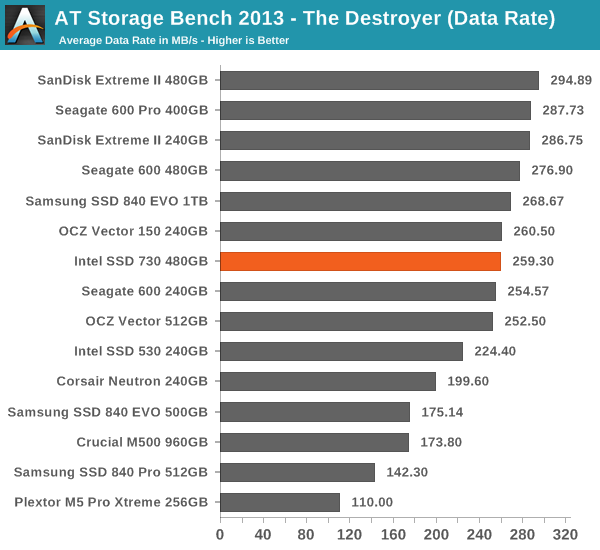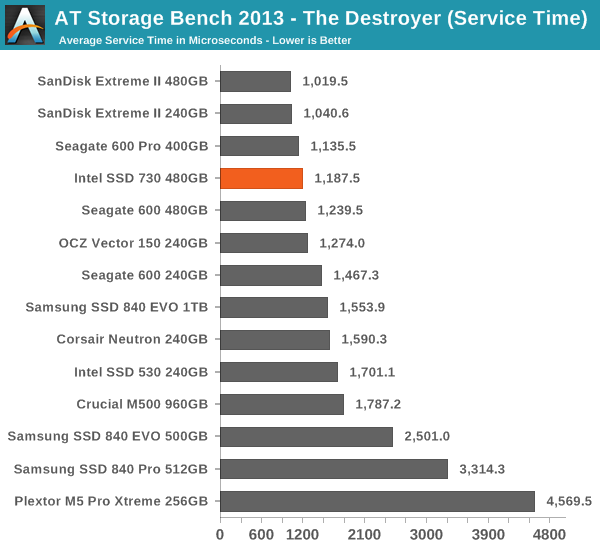Intel SSD 730 (480GB) Review: Bringing Enterprise to the Consumers
by Kristian Vättö on February 27, 2014 12:00 PM EST- Posted in
- Storage
- SSDs
- Intel
- Intel SSD 730
AnandTech Storage Bench 2013
Our Storage Bench 2013 focuses on worst-case multitasking and IO consistency. Similar to our earlier Storage Benches, the test is still application trace based—we record all IO requests made to a test system and play them back on the drive we're testing and run statistical analysis on the drive's responses. There are 49.8 million IO operations in total with 1583.0GB of reads and 875.6GB of writes. As some of you have asked, I'm not including the full description of the test for better readability, so make sure to read our Storage Bench 2013 introduction for the full details.
| AnandTech Storage Bench 2013 - The Destroyer | ||||||||||||
| Workload | Description | Applications Used | ||||||||||
| Photo Sync/Editing | Import images, edit, export | Adobe Photoshop CS6, Adobe Lightroom 4, Dropbox | ||||||||||
| Gaming | Download/install games, play games | Steam, Deus Ex, Skyrim, Starcraft 2, BioShock Infinite | ||||||||||
| Virtualization | Run/manage VM, use general apps inside VM | VirtualBox | ||||||||||
| General Productivity | Browse the web, manage local email, copy files, encrypt/decrypt files, backup system, download content, virus/malware scan | Chrome, IE10, Outlook, Windows 8, AxCrypt, uTorrent, AdAware | ||||||||||
| Video Playback | Copy and watch movies | Windows 8 | ||||||||||
| Application Development | Compile projects, check out code, download code samples | Visual Studio 2012 | ||||||||||
We are reporting two primary metrics with the Destroyer: average data rate in MB/s and average service time in microseconds. The former gives you an idea of the throughput of the drive during the time that it was running the test workload. This can be a very good indication of overall performance. What average data rate doesn't do a good job of is taking into account response time of very bursty (read: high queue depth) IO. By reporting average service time we heavily weigh latency for queued IOs. You'll note that this is a metric we've been reporting in our enterprise benchmarks for a while now. With the client tests maturing, the time was right for a little convergence.

Even though the performance consistency on the SSD 730 is great, it's only mediocre in our Storage Bench 2013. The write performance of SSD 730 is class-leading but as our Storage Bench has more read than write operations, the SSD 730 loses to drives with better read performance. Whether the drive should focus on read or write performance is a question with no single correct answer because it's workload dependent. The heavy enterprise workloads the SSD 730 platform was designed for tend to be more aggressive in writes, so giving up some read performance makes sense there and carries over into the consumer version.











96 Comments
View All Comments
futrtrubl - Friday, February 28, 2014 - link
"JEDEC's SSD spec, however, requires that client SSDs must have a data retention time of one year minimum whereas enterprise drives must be rated at only three months"I hadn't actually thought about this before for SSDs and after doing some checking around this seems to be the minimum retention time once the endurance cycles have been exhausted.
Presumable this retention time is higher for sectors that are not exhausted. Does anyone know what sort of retention times could be expected from fresh/moderately used drives?
The next question would be do controllers move once written data around to refresh this data and/or as part of wear leveling (like OS files that are untouched after the install)?
Mr Perfect - Friday, February 28, 2014 - link
I don't know about your first question, but the answer is "yes" to your second question about the wear leveling. Controllers try to keep writes even across all blocks to keep endurance up.futrtrubl - Saturday, March 1, 2014 - link
Sorry, that was a badly worded question but yes I am aware that wear leveling exists. What I am asking is, if you write a file once and then only read from it for the next few years while the rest of the drive is being written/rewritten, will the controller intentionally rewrite or move that file? Whether it does it for wear leveling or to refresh "old" data is less important but would be nice to know, if it does.Solid State Brain - Tuesday, March 4, 2014 - link
SSD-spec NAND memory is supposed to have a 10 years data retention when fresh (0 write cycles). I haven't been able to find much real world data about it, but from a Samsung datasheet about their enterprise drives, inclusing those with TLC NAND memory (here http://www.samsung.com/global/business/semiconduct... ) one can extrapolate that for the rated endurance with sequential workloads at 3 months of data retention, TLC NAND cells would have to endure about 2000 write cycles.So very roughly, assuming it's the exact same memory of the consumer drives (no reasons to assume it's not the case) for these drives we have: 0 write cycles = 10 years retention, 1000 cycles = 1 year retention, 2000 cycles = 3 months retention. Torture tests by users worldwide have shown that at over 3000 write cycles, these drives have a data retention ranging from hours to days. So, we could further summarize this as:
cycles / data retention days
0000 3650
1000 365
2000 36.5
3000 3.65
If you plot these values you can see that there's an inverse exponential correlation between NAND wear and data retention.
Solid State Brain - Tuesday, March 4, 2014 - link
It turns out I realized too late before clicking "reply" that for the 2000 cycles datapoint I used about one month of time instead of 3 months. It should be 90. It doesn't affect the end point I was making, though.SiennaPhelpsigi - Saturday, March 1, 2014 - link
Parker . I can see what your saying... Margaret `s bl0g is impressive, last thursday I bought a great Porsche 911 from having made $8447 this past month an would you believe 10 grand this past month . this is certainly the most-comfortable job I've ever had . I began this nine months/ago and pretty much immediately began to bring home over $77, per-hour . Learn More W o r k s 7 7kmmatney - Saturday, March 1, 2014 - link
You can make that kind of money, in real life, as an engineer. Why is their a shortage of engineers in the U.S.again?Jflachs - Saturday, March 1, 2014 - link
So um, the 840 Pro is still the best SSD then, right?emn13 - Sunday, March 2, 2014 - link
None of samsungs drives have any form of power loss protection, so unless you really need that last bit of performance, I'd avoid them, especially since there are cheaper drives that do have that protection.If you really do need top-of-the line performance, well, then your choice becomes considerably harder.
amddude10 - Friday, November 28, 2014 - link
Power-loss protection isn't very important in a laptop or if someone has a good UPS on a desktop, or at least that's what I would think, so in those cases, samsungs look very good indeed.